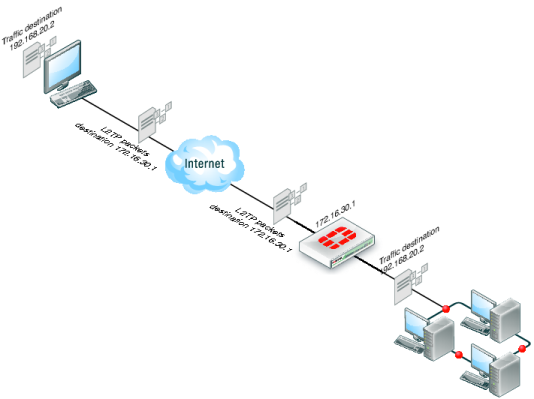Configuring L2TP VPNs
This section describes how to configure a FortiGate unit to establish a Layer Two Tunneling Protocol (L2TP) tunnel with a remote dialup client. The FortiGate implementation of L2TP enables a remote dialup client to establish an L2TP tunnel with the FortiGate unit directly.
According to RFC 2661, an Access Concentrator (LAC) can establish an L2TP tunnel with an L2TP Network Server (LNS). In a typical scenario, the LAC is managed by an ISP and located on the ISP premises; the LNS is the gateway to a private network. When a remote dialup client connects to the Internet through the ISP, the ISP uses a local database to establish the identity of the caller and determine whether the caller needs access to an LNS through an L2TP tunnel. If the services registered to the caller indicate that an L2TP connection to the LNS is required, the ISP LAC attempts to establish an L2TP tunnel with the LNS.
A FortiGate unit can be configured to act as an LNS. The FortiGate implementation of L2TP enables a remote dialup client to establish an L2TP tunnel with the FortiGate unit directly, bypassing any LAC managed by an ISP. The ISP must configure its network access server to forward L2TP traffic from the remote client to the FortiGate unit directly whenever the remote client requires an L2TP connection to the FortiGate unit.
When the FortiGate unit acts as an LNS, an L2TP session and tunnel is created as soon as the remote client connects to the FortiGate unit. The FortiGate unit assigns an IP address to the client from a reserved range of IP addresses. The remote client uses the assigned IP address as its source address for the duration of the connection.
More than one L2TP session can be supported on the same tunnel. FortiGate units can be configured to authenticate remote clients using a plain text user name and password, or authentication can be forwarded to an external RADIUS or LDAP server. L2TP clients are authenticated as members of a user group.
| FortiGate units support L2TP with Microsoft Point-to-Point Encryption (MPPE) encryption only. Later implementations of Microsoft L2TP for Windows use IPSec and require certificates for authentication and encryption. If you want to use Microsoft L2TP with IPSec to connect to a FortiGate unit, the IPSec and certificate elements must be disabled on the remote client |
Traffic from the remote client must be encrypted using MPPE before it is encapsulated and routed to the FortiGate unit. Packets originating at the remote client are addressed to a computer on the private network behind the FortiGate unit. Encapsulated packets are addressed to the public interface of the FortiGate unit. See
Figure 244.
When the FortiGate unit receives an L2TP packet, the unit disassembles the packet and forwards the packet to the correct computer on the internal network. The security policy and protection profiles on the FortiGate unit ensure that inbound traffic is screened and processed securely.
See Also
FortiGate units cannot deliver non-IP traffic such as Frame Relay or ATM frames encapsulated in L2TP packets — FortiGate units support the IPv4 and IPv6 addressing schemes only


